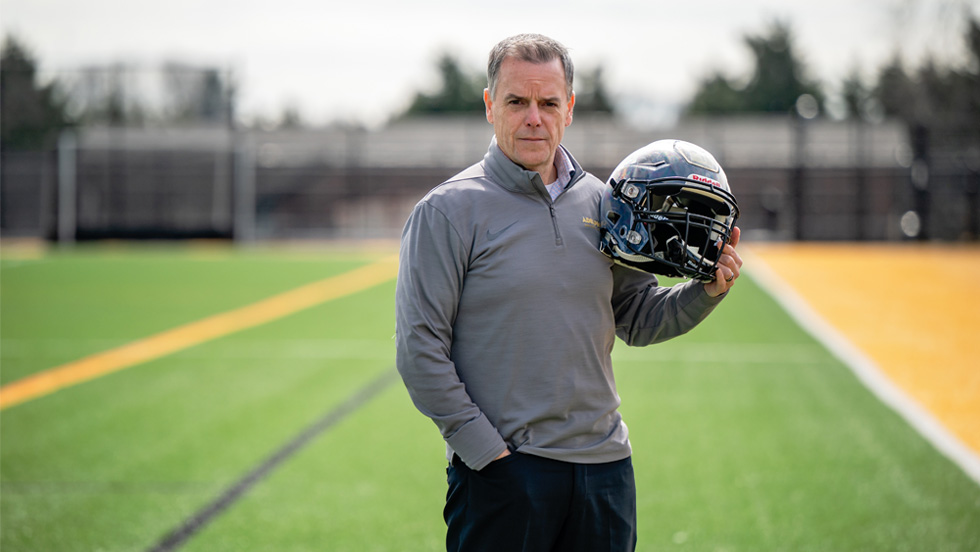
Can practicing without helmets make the sport safer?
Football is the most popular sport in the United States, and Americans are unlikely to ever give it up, despite its well-documented dangers—so it’s down to educators and researchers to improve safety efforts and reduce the risk of injury, particularly for youth players.
Erik Swartz, PhD, vice dean and professor in the Adelphi University Ruth S. Ammon College of Education and Health Sciences, is leading the charge to tackle this issue. Using data from a long-term study conducted among high school football players in Hawaii, Dr. Swartz has once again demonstrated the efficacy of a training program that decreases the number of head impacts a player will experience during a game of tackle football.
He and his research team recently published two papers on the topic: “Helmetless Tackling Training Intervention and Preseason Self- efficacy Effects on Head Impacts in Hawai′i High School Football” (Clinical Journal of Sport Medicine, July 2024)1 and “Head Impact Exposure in Hawaiian High School Football: Influence of Adherence Rates on a Helmetless Tackling and Blocking Training Intervention” (Journal of Athletic Training, April 2024).2
Research on helmetless tackling training (HuTT®) programs has been Dr. Swartz’s main focus for a decade. “HuTT® is a bona fide intervention to try and control a medical or health problem, such as concussions or head injuries,” he said. Training that teaches players how to tackle and block without a helmet on, Dr. Swartz and his collaborators have found, ensures players are far more prepared when the helmet goes on at game time. The idea may seem counterintuitive, but Dr. Swartz’s research has shown over and over again that it works. “When players do this specific type of tackling training program during the season,” he explained, “they get better at keeping their head out of the way when they’re going into tackling and blocking in football.”
In Hawaii, a prominent attorney named Gary Galiher, JD, became passionate about the danger posed by CTE (chronic traumatic encephalopathy) when he represented the case of a football player diagnosed after his death with CTE. Galiher’s foundation, which supports research into making football safer and reducing the frequency of traumatic head injuries in the sport, provided the means for Dr. Swartz and his colleagues to design a longitudinal study measuring the impact of HuTT® programs at Hawaiian schools.
At five different high schools, among multiple different levels of play, from freshman to varsity, Dr. Swartz’s team helped coaches implement helmetless drills. They then assessed the impact of the drills using sensors embedded in the lining of players’ helmets during games.
Despite an interruption to their data collection process during the COVID-19 pandemic, Dr. Swartz’s team was able to gather data from nearly 500 players. They analyzed the number and intensity of head impacts, as well as reported data from self-efficacy surveys conducted before and after the training intervention. “We also wanted to understand whether or not the participants were gaining in confidence in their ability to safely tackle and block,” Dr. Swartz said.
The results from the study were striking. Dr. Swartz’s team saw a significant reduction in the number of head impacts throughout the season for players who adhered to the training intervention on at least a 60 percent level. They also found a correlation between increased uptake of the intervention and increased confidence among players in their ability to tackle and block safely.
Although the study only measured physical impacts, and not medical outcomes like concussions, Dr. Swartz believes HuTT® could one day meaningfully contribute to a reduction in head injuries among professional players.
By showing that coaches can train players out of receiving unnecessary impacts, Dr. Swartz’s research promises to support high school and amateur teams who cannot afford expensive equipment upgrades. “The NFL has gotten a lot of press around adding protective layers to helmets, which actually makes the work that we’re doing that much more important,” he said. “We’re getting the word out about other solutions.”
Read more in the 2025 issue of Academic & Creative Research Magazine, where we highlight the innovation and imagination shaping Adelphi’s academic community.
1 Lloansi Rodriguez, I., Freemyer, B., Hashida, K., Tamura, K., Murata, N., Furutani, T., Gioia, G., Myers, J., & Swartz, E. (2024). Helmetless tackling training intervention and preseason self-efficacy effects on head impacts in Hawai′i High School football. Clinical Journal of Sport Medicine. https://doi.org/10.1097/jsm.0000000000001246
2 Swartz, E., et al. (2024). Head impact exposure in Hawaiian high school football: Influence of adherence rates on a helmetless tackling and blocking training intervention. Journal of Athletic Training. https://doi.org/10.4085/1062-6050-0014.24
About Erik Swartz, PhD
Erik Swartz, PhD, is vice dean and professor in the Ruth S. Ammon College of Education and Health Sciences. For more than 20 years, his research has focused on the prevention and acute care of head and neck injuries in football. Dr. Swartz has been published in over 30 scholarly journals, received grants from organizations including the National Athletic Trainers’ Association Foundation and NFL Charities, and served on the NFL Head Neck and Spine Committee’s Subcommittee on Safety Equipment and Rules.